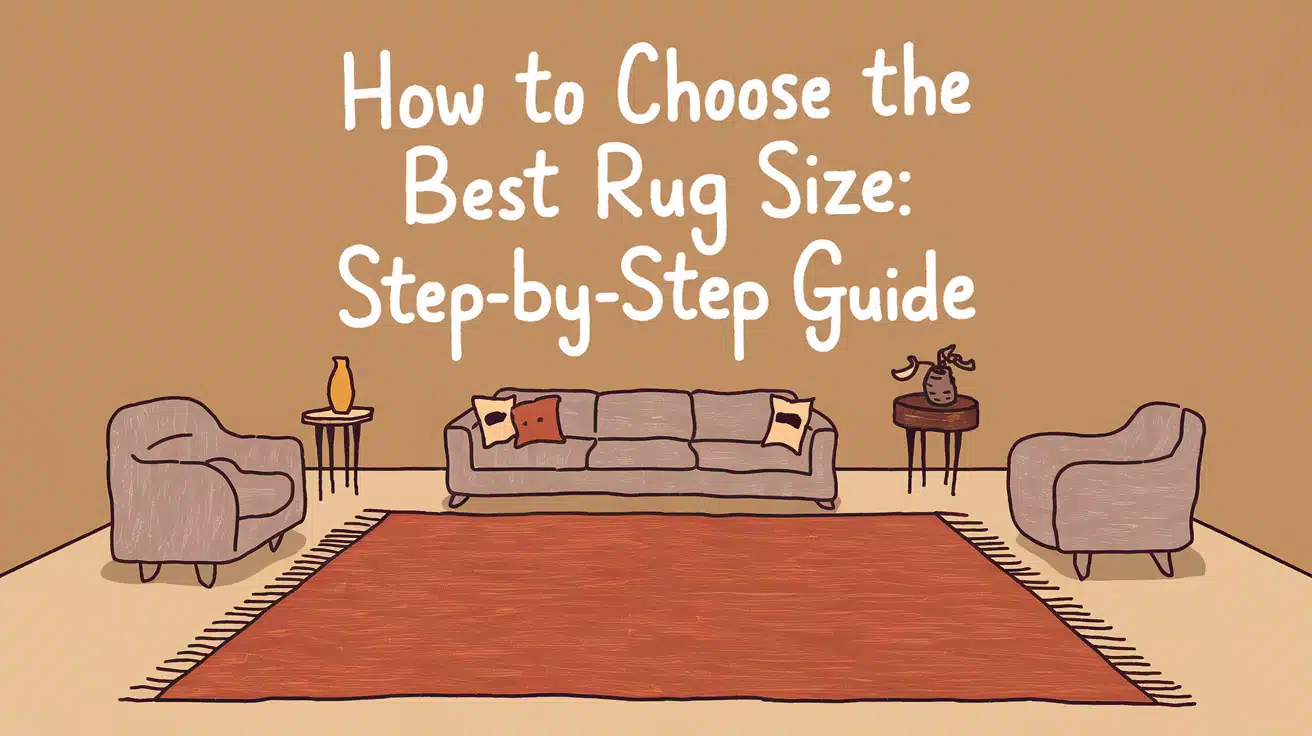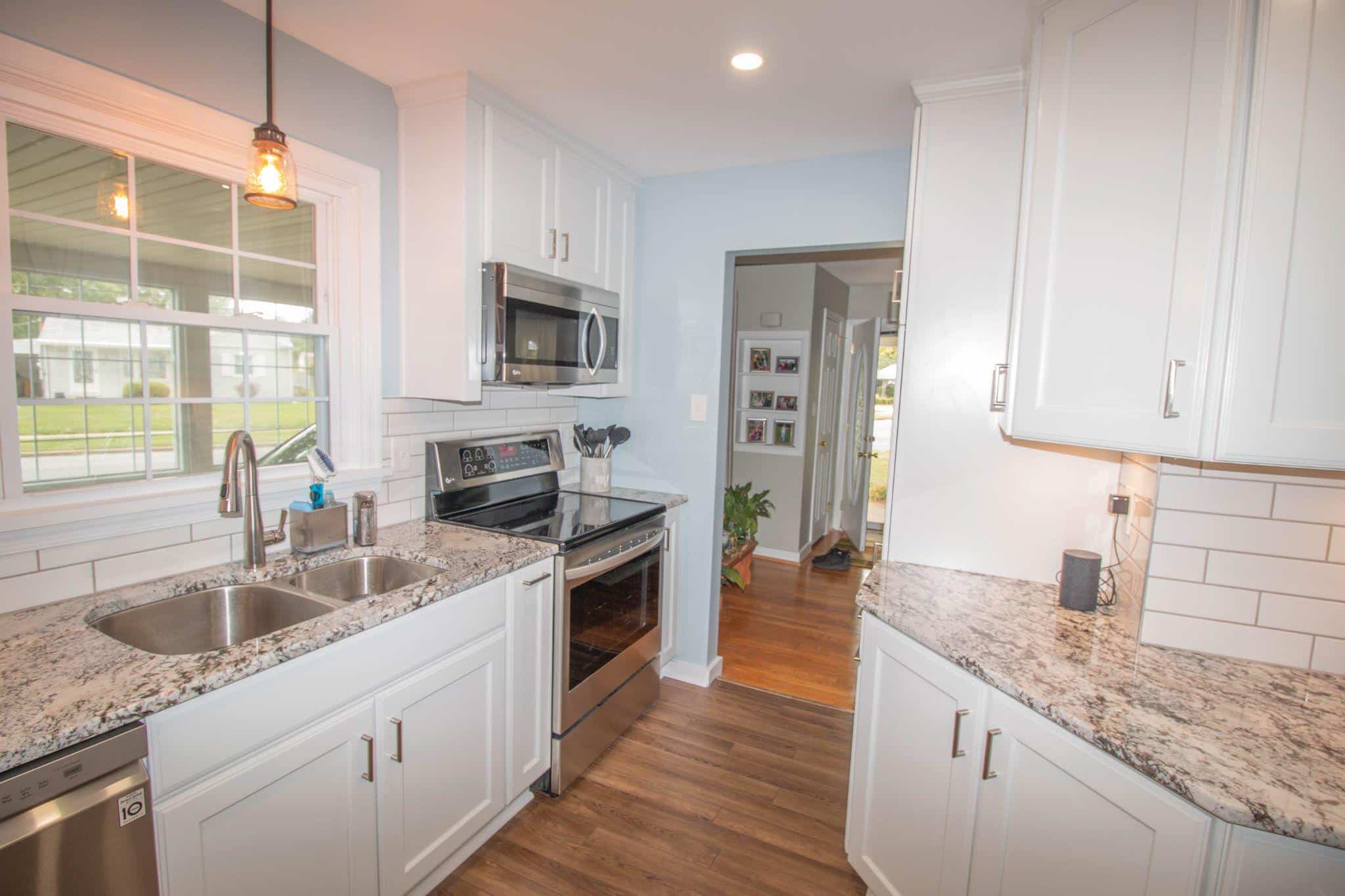Buying a rug seems simple until you get it home and realize it’s completely wrong for your space.
Trust me, I’ve seen this happen countless times – a beautiful rug that makes a room look awkward because it’s the wrong size.
Here’s the good news: I’ve developed a foolproof method to help you pick the perfect rug size every time: no more guesswork or costly mistakes.
Using the designer’s golden rule of 4-6 inches and some simple measurements, you’ll nail the right dimensions on your first try.
In this guide, I’ll walk you through exactly how to measure your space, understand standard rug sizes, and apply professional sizing principles that work for every room.
Ready to become a rug-sizing expert?
Essential Tools for Rug Size Selection
Before diving into measurements, let’s gather the right tools. Here’s what you’ll need for accurate rug sizing:
| Tool | Details |
|---|---|
| Tape Measure | A long, retractable measuring tape (25 feet minimum) Metal tape is preferred over fabric for accuracy Consider a laser measure for large spaces |
| Paper and Sketching Materials | Graph paper works best for scale drawings Sharp pencil for precise lines Ruler for straight edges Eraser for adjustments |
| Calculator | The phone calculator works fine Add 6-12 inches easily for borders Calculate total square footage quickly |
| Room Layout Plan | Current furniture arrangement Planned furniture placement Door swing paths marked Traffic patterns noted Window locations Built-in features (fireplace, bookcases) |
The Golden Rule: Master Your Rug Measurements
Follow these essential steps to achieve perfect rug sizing for any room:
Step 1: Start with the Golden Rule
- Keep 4-6 inches of space between rug edges and walls
- Maintain consistent borders around furniture
- Mark these margins with painter’s tape for visual guidance
Step 2: Map Your Largest Furniture First
- Measure your biggest piece (like your sofa) first
- Note down the length and width
- Include any chaise extensions or unusual shapes
- Account for furniture feet placement
Step 3: Calculate Border Allowances
- Add 6 inches to each side of the furniture measurements
- Double-check diagonal measurements for oddly shaped pieces
- Mark your measurements on your floor with tape
- Step back and assess the visual balance
Step 4: Consider Room Features
- Note heating vent locations
- Mark doorway clearances
- Account for built-in cabinets
- Check fireplace hearth extensions
Step 5: Plan for Traffic Flow
- Map main walking paths
- Ensure rug edges don’t create tripping points
- Allow extra space in high-traffic zones
- Consider door swing areas
Step 6: Compare with Standard Sizes
- Match your measurements to available sizes
- Round up to the next standard size if needed
- Consider custom sizing for unusual spaces
- Factor in standard size cost differences
Step 7: Double-Check Measurements
- Verify all dimensions twice
- Test furniture placement within marked areas
- Ensure symmetry where needed
- Take photos of your tape outline for reference
Pro Tip: If you’re between standard sizes, it’s better to size up rather than down. A slightly larger rug looks more intentional than one that’s too small.
Video Tutorial
Check out this YouTube video for a detailed step-by-step tutorial on How to Choose the Best Rug Size.
Room-by-Room Rug Sizing Guide
Living Room Layout Tips
- Place the front legs of all seating on the rug at a minimum
- For open-plan spaces, use the rug to anchor conversation areas
- Keep 18-24 inches of bare floor between the rug edge and walls
- Position your coffee table in the center
- Factor in side table placement
Bedroom Rug Placement
- Position the rug to extend 24-36 inches beyond bedside
- Place rug 2/3 under the bed, starting at the headboard
- For king beds, opt for a minimum 9′ x 12′ size
- For queen beds, choose a minimum 8′ x 10′ size
- Ensure the rug extends at least 18 inches beyond the bed footboard
Dining Room Success Strategies
- Add 36 inches beyond table edges for chair movement
- Center the carpet under light fixtures above
- For rectangular tables, match the rug shape to the table
- Factor in buffet or server furniture placement
- Test chair movement before finalizing placement
Pro Tip: Place a piece of cardboard in your planned rug size and test chair movement for a week in dining rooms. This real-life test helps confirm your measurements work for daily use.
Expert Tips for Perfect Rug Placement
Solutions for Oversized Spaces
- Talk to carpet retailers about custom cuts
- Request samples to test colors in your space
- Compare remnant options for cost savings
- Look for end-of-roll deals
- Ask about binding options for finished edges
Money-Saving Strategies
- Shop during seasonal sales (typically January and July)
- Consider indoor/outdoor rugs for high-traffic areas
- Look at remnant sections in carpet stores
- Ask about floor sample discounts
- Check return policies before purchasing
Rug Pad Essentials
- Choose 1/4 inch thickness for standard rugs
- Pick thicker pads (3/8 inch) for plush rugs
- Cut pads 1 inch smaller than rug edges
- Replace pads every 3-5 years
- Vacuum under pads monthly
Care and Maintenance Tips
- Rotate rugs every 6 months
- Address spills immediately
- Keep cleaning supplies handy
- Schedule professional cleaning yearly
- Document cleaning methods for warranty
Pro Tip: For open floor plans, try layering rugs. Use a large, neutral base rug with smaller, decorative rugs to define different areas while maintaining flow.
Safety Note: Always use appropriate rug pads – they protect your flooring and your rug while preventing dangerous slips.
Quick Reminder: Take photos of your room’s lighting at different times of day before making final rug selections. Colors and patterns can look quite different under varying light conditions.
Smart Solutions for Special Situations
| Category | Details |
|---|---|
| Musical Instrument Placement | Place pianos on rugs 2 feet larger than piano dimensions Select dense, low-pile rugs for better sound quality Keep humidity requirements in mind Factor in piano leg support needs Choose durable fibers that resist furniture marks |
| High-Traffic Area Solutions | Pick dark patterns to mask wear Select synthetic fibers for durability Look for stain-resistant treatments Consider indoor/outdoor options Choose low-pile styles for easy cleaning |
| Smart Shopping Strategies | Take advantage of end-of-season sales Request price matching from retailers Sign up for store newsletters for early sale alerts Keep measurements on your phone Ask about remnant options |
| Return Policy Checklist | Check return timeframes Understand restocking fees Read delivery damage policies Save all packaging materials Take photos when unpacking |
Pro Tip: Create a digital folder with room measurements, photos, and color preferences. This information makes shopping much easier, whether online or in stores.
Conclusion
Selecting the right rug size might seem like a puzzle initially, but with these guidelines, you’re ready to make a confident choice.
Remember, taking accurate measurements and following the golden rule of 4-6 inch borders will steer you toward success every time.
Keep this guide handy next time you’re rug shopping – whether furnishing a cozy bedroom or defining spaces in an open floor plan.
And don’t forget my favorite tip: tape out your chosen rug size on the floor before purchasing. It’s a simple step that can save you from costly mistakes.
Ready to start your rug-sizing voyage?
Grab your tape measure and transform your space with the perfect rug size.











